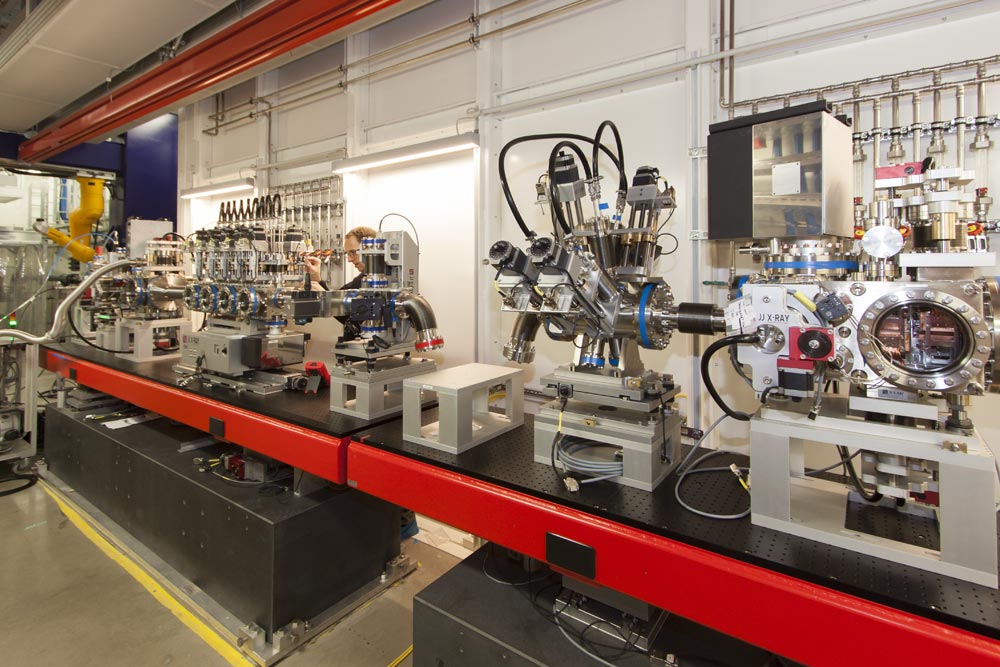

<b>FXE instrument</b>
The FXE instrument, which is currently being assembled in its hutch in the European XFEL experiment hall, will enable studies of ultrafast processes such as decisive intermediate steps of chemical reactions. The X-ray laser flashes enter the instrument from the right side of the picture and travel through a series of complex optics and diagnostics before arriving at the sample interaction region. A yellow robot arm for one of the instrument's detectors is seen in the background to the left.
Copyright: European XFEL
An international panel of experts will review the proposals on the basis of scientific excellence. After successful review of their proposals, research groups are granted access to use the European XFEL—that is, the extremely brilliant X-ray light flashes at one of the facility’s instruments—for a few days for their research projects. Use of the facility is free of charge provided the results are made generally available through publication.
Like other X-ray light sources, the European XFEL is a research facility that provides capabilities and scientific knowhow for external researchers. The start of user operation will mark one of the final big milestones in the commissioning of the 3.4 km long X-ray laser.
The first two instruments in the experiment hall for which proposals can be submitted are the Femtosecond X-Ray Experiments (FXE) instrument and the Single Particles, Clusters, and Biomolecules and Serial Femtosecond Crystallography (SPB/SFX) instrument. FXE enables investigations of ultrafast processes and the creation of “molecular movies”, which show the progression of an individual reaction with high precision.
This will give impulses to many areas of research, including studies of mechanisms of various diseases at the molecular level, energy research, or the optimization of chemical processes. The second instrument, SPB/SFX, is specialized for research into biomolecules and other biological materials. Understanding the atomic-level details of biomolecules can enable the development of new medications and therapies. With the European XFEL, scientists will be able to determine structures from tiny crystals of biomolecules.
These crystals will be easier to create than the larger crystals needed for X-ray light sources up to now, which can take years or even decades to produce. In addition, it is expected that X-ray lasers in the medium term will also pave the way for structural determination of individual, uncrystallised molecules.
Currently, the European XFEL is in the process of being put into operation. The next steps that follow are the further commissioning of accelerator sections, the generation of X-ray laser light (first lasing), and the commissioning of the instruments. After the first experiment campaign starting in the fall, the equipment at the instruments and the options for experiments will be increased or further improved until the full capabilities of the European XFEL are reached.
The current programme for the first experiments is planned for a two-month period. The next announcement of experiment time is expected in summer 2017 for experiments in the first half of 2018. From 2018 on, four further instruments will be available, each of which is dedicated to specific applications and research themes.
More information about the announcement of experiment time can be found at www.xfel.eu
About European XFEL
The European XFEL, currently being commissioned in the Hamburg area, is an international research facility of superlatives: 27 000 X-ray flashes per second and a brilliance that is a billion times higher than that of the best conventional X-ray sources will open up completely new opportunities for science. Research groups from around the world will be able to map the atomic details of viruses, decipher the molecular composition of cells, take three-dimensional “photos” of the nanoworld, “film” chemical reactions, and study processes such as those occurring deep inside planets. The construction and operation of the facility is entrusted to the European XFEL GmbH, a non-profit company that cooperates closely with the research centre DESY and other organizations worldwide. The company, which has a workforce of about 280 employees, expects to start user operation of the facility in the second half of 2017. With construction and commissioning costs of 1.22 billion euro (at 2005 price levels) and a total length of 3.4 kilometres, the European XFEL is one of the largest and most ambitious European research projects to date. At present, 11 countries have signed the European XFEL convention: Denmark, France, Germany, Hungary, Italy, Poland, Russia, Slovakia, Spain, Sweden, and Switzerland.
Contact:
Bernd Ebeling
++49 8998 6921
bernd.ebeling@xfel.eu
http://media.xfel.eu/XFELmediabank/?l=en&c=15298 Picture of the FXE instrument












